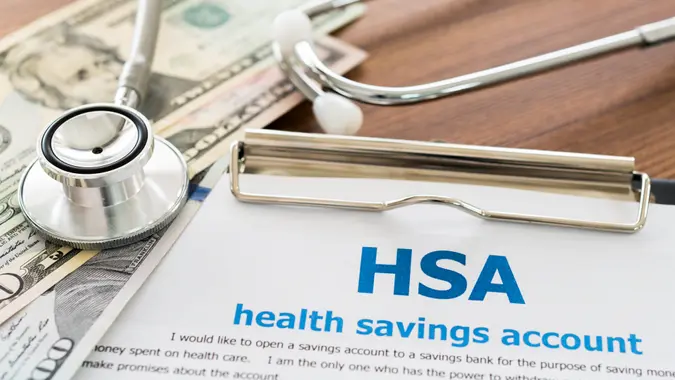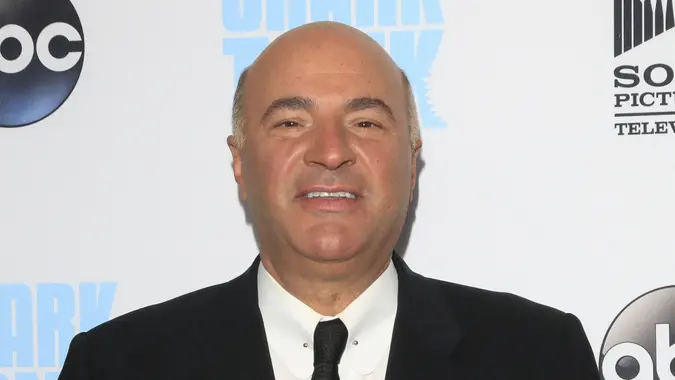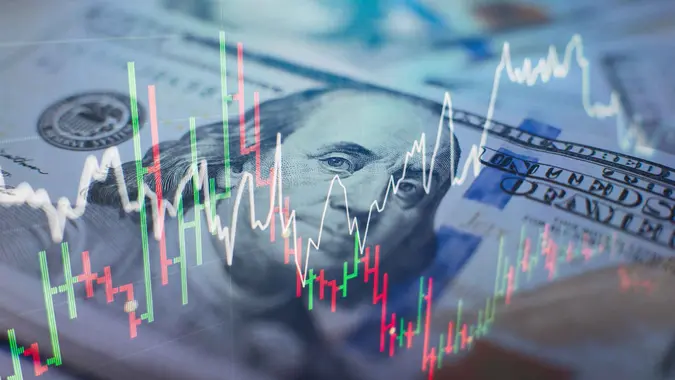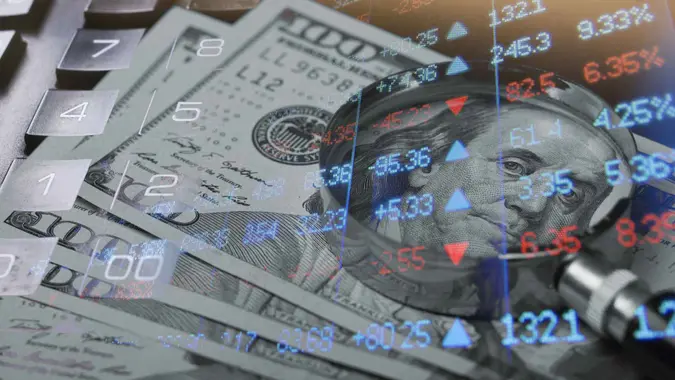9 Best Safe and Low-Risk Investments for September 2024

Commitment to Our Readers
GOBankingRates' editorial team is committed to bringing you unbiased reviews and information. We use data-driven methodologies to evaluate financial products and services - our reviews and ratings are not influenced by advertisers. You can read more about our editorial guidelines and our products and services review methodology.

20 Years
Helping You Live Richer

Reviewed
by Experts

Trusted by
Millions of Readers
A high return is what every investor is after, but it’s not the only factor that matters. When reviewing investments, professionals look not only at absolute return potential but also something called “risk-adjusted return.”
The bottom line is that not all returns are created equal, and smart investors look to invest where they’re getting the best value for the risk that they are taking on — even if that means accepting lower returns.
Through that lens, you might prefer an investment that pays just 2% a year over one that’s returning 20%. Why? Because if that 2% return is guaranteed, but the path to the 20% return involves the risk of losing 40%, that steady 2% could be a better value over time, based on its low risks — especially for a risk-averse investor.
For the individual investor, this balance is all the more important. If you understand how comparing investments requires looking at both returns and the risk with equal weight, you can understand how even a tiny return can be a great deal if the investment is really risk-free.
9 Best Safe Investments
Here are the nine best safe and low-risk investments:
- High-yield savings accounts
- Certificates of deposit
- Money market accounts
- Treasury bonds
- Treasury Inflation-Protected Securities
- Municipal bonds
- Corporate bonds
- S&P 500 index fund/ETF
- Dividend stocks
You’re unlikely to generate exponential growth with these, but you’re even less likely to lose the money you’re relying on to keep you and your family secure.
1. High-Yield Savings Accounts
The high-yield savings account is pretty much the gold standard of safe investments, offering you strong returns given the total absence of risk. The money you have stashed in almost any bank is insured by the Federal Deposit Insurance Corp., meaning the government will make you whole on any losses up to $250,000.
One of the few catches with high-yield savings accounts is that rates can change in response to current market conditions. When rates are falling, payouts can seem not as attractive.
Rates have been creeping up since early 2022, and top high-yield savings accounts are paying over 5% for the first time in years. With the national average savings rate hovering at 0.46% as of Aug. 19, high-yield savings accounts are a great deal.
Although perhaps not as exciting as potential stock market returns, high-yield savings accounts are very liquid investments, meaning it’s easy to access your money without penalty if you need it quickly. That makes stashing your emergency fund — something you better have if you’re really looking to limit your financial risk — a pretty decent investment.
Bottom Line: FDIC insurance means your money is 100% safe. It’s easy to get a hold of in a pinch, and rates are well above the national average savings account rate.
- Stashing your emergency fund
- Investors looking for options without any risks
2. Certificates of Deposit
Certificates of deposit are almost identical to savings accounts. Most are FDIC insured, so there’s zero risk involved. However, they are still liquid.
With a CD, you accept a time horizon when you invest — usually anywhere from one month to up to 10 years. Although a few CDs allow you to withdraw the money early without consequence, you generally must pay a penalty if you access your cash before the CD term ends. On the one hand, that makes CDs much less valuable for your emergency fund or savings.
On the other, it should mean you’ll get paid a higher rate of return in exchange for that loss of easy access. Basically, banks will have an easier time reinvesting your savings if you’ve promised to leave it alone for a set amount of time.
Before you get a CD, consider the following:
- Whether or not you might need that money before the CD’s maturity date. If the answer is yes, you’ll want to look elsewhere.
- Whether you really are getting a better interest rate than is available with high-yield savings accounts. Your only advantage with a CD over a savings account is getting better returns, so if you can find a savings account that pays better than the CDs at your bank, there’s just no point.
That said, an FDIC-insured CD’s returns might seem modest, but they’re pretty stellar in the context of the near-total absence of any risk to you of losing money.
Bottom Line: CDs should offer higher returns than most savings accounts, but that comes at a loss of flexibility as you’ll typically owe a penalty for pulling your money out early.
Best For:
- Money you can be sure you won’t need for the prescribed time frame
- Investors with a stable financial picture looking to avoid any risk in their investments
3. Money Market Accounts
Money market accounts operate on similar principles to CDs or savings accounts. They usually offer better rates than savings accounts, but they also come with more liquidity than CDs and might even let you write checks or use a debit card with the account, allowing for greater flexibility when used alongside a savings account.
If you’re using the account just to make deposits and write a monthly rent check, for instance, the MMA could be ideal. However, it has everything to do with the return, so shop around and compare your options not just with other money market accounts but with CDs and high-yield savings accounts as well.
Also, note that the main caveat with a money market account is that many banks will enforce a limit of six transactions a month. Exceed that and you’ll be fined; keep exceeding it and the bank will have to convert your account to a checking account or perhaps even close your account.
Bottom Line: Money market accounts are very similar to savings accounts but offer the option to write a limited number of checks each month.
Best For:
- Money you might need to use infrequently
- Investors looking for a little more flexibility than their savings account offers
Good To Know
The FDIC insurance limit of $250,000 is applied per bank, per person, per account ownership category — not for each account. So, if you have a savings account, CD and MMA at the same bank and they have a combined $300,000 in them, you’re not insured on $50,000 of that money.
4. Treasury Bonds
Even though a 5% return on a high-yield savings account is more than you’re likely to get on a regular savings account at your bank, you will probably need at least some investments that are taking a bit more risk if you want to build a strong portfolio. Bonds are the next tier up from banking products in terms of higher risk and higher returns, which are essentially structured loans made to a large organization.
Treasury bonds, also known as T-bonds, are guaranteed by the full faith and credit of the U.S. government. On your end, Treasurys will act just like a CD in many ways. Here’s how it works:
- You invest with a set interest rate and a term of 20 or 30 years.
- You’ll get regular “coupon” payments for the interest while you hold the bond, and then your principal is returned when the bond matures.
While your coupon payments are completely predictable and secure, the face value of your bonds will rise and fall over time based on the prevailing interest rates, stock market performance and any number of other factors. Granted, that could work out in your favor, but only because you’ve taken on additional risk. So if you aren’t reasonably certain you can hold the bond to maturity, it’s definitely a riskier investment.
Keep in Mind
Unlike with a CD, you can’t pull out your money before the maturity date, not even for a penalty. That doesn’t mean you’re stuck — you can easily go out and sell the bond on the secondary market. But at that point, you’ve gone from buying and holding Treasurys to maturity, which tends to be incredibly safe, to trading bonds — vastly less safe.
Bottom Line: Debt issued by the Treasury is backed by the full faith and credit of the U.S. government, making it similarly as free from risk as FDIC-insured bank accounts.
- Money you know you won’t need prior to the maturity date of the bond
- Funds in excess of the $250,000 insured by the FDIC
- Investors willing to give up some flexibility in search of slightly better returns
5. Treasury Inflation-Protected Securities
Many people turn to Treasury Inflation-Protected Securities, or TIPS, in response to inflation. Your interest payments are going to be considerably lower than what you would earn on a normal Treasury of the same length. However, you’re accepting that lower rate because your principal will increase or decrease in value to match inflation as measured by the consumer price index. With inflation at 3% in June 2024, TIPS investors are sitting pretty while people who bought bonds at a fixed 2% rate are basically losing 1% a year.
Like any other Treasurys, you expose yourself to all sorts of additional risk if you have to sell TIPS before they mature, so you should make sure you won’t need to access that money prior to maturity.
Bottom Line: TIPS offer lower yields, but the principal will increase or decrease in value based on the prevailing inflation rates while you hold the bond.
- Money you know you won’t need prior to the maturity date of the bond
- Funds in excess of the $250,000 insured by the FDIC
- Investors looking for Treasurys but interested in removing inflation-based risk from their portfolio
6. Municipal Bonds
Municipal bonds, which are issued by state and local governments, are a good option for slightly better returns with only slightly more risk. There’s almost no chance of the U.S. government defaulting, but there are definitely cases of major cities filing for bankruptcy and losing their bondholders a lot of money.
A bankruptcy by a major city is pretty rare, but if you want to be extra safe, you could steer clear of any cities or states with large, unfunded pension liabilities.
And because the federal government has a vested interest in keeping borrowing costs low for state and local governments, it has made interest earned on munis tax-exempt at the federal level. In some cases, munis are exempt from state and local taxes as well. So not only are they usually still safe, but they come with the added bonus of reducing your tax bill when compared with many other options.
Bottom Line: These debts issued by state and local governments are a little riskier than Treasurys but come with the bonus of being untaxed at the federal level.
- Taking on marginally more risk in pursuit of marginally better returns
- Investing while also keeping your tax bill as low as possible
- Investors looking for relatively safe bonds
7. Corporate Bonds
Like governments of various sizes, corporations will also issue debt by way of selling bonds. Like munis, this can mean you’re still in safe territory, but it’s also no sure bet. Plenty of corporations that are teetering on the edge of solvency will offer high yields for the high risk — usually referred to as “junk bonds” — and those aren’t a great call if you’re looking for something really safe.
Although corporate bonds are inherently riskier than Treasurys and often riskier than munis, if you’re sticking to major, blue-chip public companies and holding the bonds to maturity, they’re still in the realm of being very safe.
Fortunately, you’re not left to guess how financially sound a company is. Public companies regularly issue financial reports detailing assets, liabilities and income, so you can get a clear sense of where they stand.
And if you, like most people, don’t really know your way around a balance sheet or income statement, you can rely on rating agencies like Moody’s or S&P Global Ratings. In most cases, an AAA-rated bond represents minimal risks if you hold it to maturity.
Bottom Line: These debts issued by corporations are just a bit riskier than munis but usually offer just a bit more interest income.
Best For:
- A measured increase in your portfolio’s risk to improve returns
- Investors looking to diversify their bond holdings
8. S&P 500 Index Fund/ETF
Stock markets can be incredibly volatile, and on any given day, you might gain or lose a big chunk of your investment. If you have money you can afford to risk in the stock market, an S&P 500 index mutual fund or exchange-traded fund can be a lower-risk way to get your feet wet. These funds track the S&P 500 index, which includes the 500 largest U.S. public corporations, as measured by market capitalization. The companies represent a variety of market sectors, so the S&P 500 is widely viewed as a barometer of the U.S. stock market and the U.S. economy as a whole.
Diversifying Your Portfolio
Using index funds or ETFs can build diversification into your portfolio. Any one company can befall a disaster, but if you own shares of a fund holding stock of different companies, you’re spreading that risk out by a lot. All the better if you’re getting shares in large, stable companies that are known as “blue chip stocks” in investing parlance.
One company might sink due to a disaster, but a few hundred at the same time? It’s highly unlikely.
Owning Stocks for the Long Term
Another strategy to defray much of the risk of stock investments is to own stocks for a very, very long time. While stock markets are incredibly chaotic over any one week, month or even year — as demonstrated by a roughly 20% drop in the S&P 500 between January and December 2022 — they actually become remarkably predictable when you look at them in terms of decades.
Over its history, the S&P 500 has returned about 10% a year. And although there have been years where even the best stocks have plunged 30% or 40%, the markets have always rebounded over the following years.
Good To Know
If you had owned an S&P 500 ETF during the 2008 financial crisis, your investment would have lost almost half its value in just a few months, but over the next eight years, your investment would have averaged 18% per year. So if you’re treating stock investments as being illiquid and only investing money you can be confident you won’t need to tap into for a few years, you’ll have the flexibility to wait out a nasty downturn in the economy and recover.
Why Choose the S&P 500 Index?
The S&P 500 is one of the most popular options for index investments. The index includes almost all blue chip stocks and has a long history of returning roughly 10% a year — an incredible return for how little risk is involved over a long time frame. You might also consider the Russell 1000, which is made up of the 1,000 most valuable American companies — giving you double the diversification.
Bottom Line: Stocks are riskier than bonds, but by purchasing large funds that represent hundreds of stocks and holding them for very long time periods, you can mitigate much of that risk and enjoy strong returns compared with bonds.
- Long-term investments you won’t be cashing in for years or even decades
- Younger investors with plenty of time to be patient with the fluctuating markets
- Investors interested in growing their money at a faster rate than bonds and banking products can provide
9. Dividend Stocks
Dividend stocks present some especially strong options for a few reasons. A dividend is a regular cash payment issued to shareholders — really the most direct way a stock can relay business success back to its investors. It also typically means some important things for the risk profile of that stock.
Here are some factors to consider when assessing a stock’s risk:
- That dividend is much more consistent and gets paid out whether the stock is up or down. Even if your stock is underperforming in terms of its share value, you’re still getting something back, making it easier to hold on to the stock and wait out a downswing.
- The dividend acts as something of a bulwark against falling share prices. Dividends are set as a per-share payment, but investors typically focus on the “dividend yield,” which is the percentage of a company’s share price that will be returned as dividends in a given year. As stock prices fall, you’re paying less for that same dividend.
- The higher that yield gets, the harder it’s going to be for bargain-hunting dividend investors to pass it up. That’s not going to mean much for a company that’s obviously headed for bankruptcy — a bad investment regardless of the dividend yield — but it will help prop up the share price for a company that’s just going through some tough times.
Companies can and will slash their dividends in times of extreme hardship. It’s rare, as it usually results in the stock plunging — consistency is what people like about dividends, so they tend to react very poorly when a dividend appears less secure. But dividend payments are less secure than the coupon payment on a bond, for example, which is fixed.
That said, if you shop around for companies that not only offer a strong yield but have a long track record of consistently increasing their dividend on a regular basis — sometimes referred to as Dividend Aristocrats — you can mitigate a lot of that risk.
Bottom Line: Owning stock in an individual company is much riskier than the other options, but dividend stocks will provide a steady return whether markets are up or down.
Best For:
- Long-term investments that still produce passive income
- Investors looking to invest in order to create a regular income stream
- Younger investors reinvesting dividends to maximize growth
How Safe Investments With High Returns Compare
The ideal portfolio is one with both minimal risk and maximum returns — even better if you have safe investments with high returns. There’s always some compromise necessary to find the right balance. Although the relative certainty provided by your savings account is great, the returns it will provide aren’t quite enough on their own to really build wealth.
Likewise, while the returns provided by an S&P 500 fund are much better over the long run, it’s important to look at them in the context of the risk that you must accept — most notably, the risk of double-digit percentage losses over the short-term — that insured banking products just don’t have.
FAQ
Here are some of the questions people ask when deciding where to invest their money.- What is the safest investment with the highest return?
- Unfortunately, the safest investments don't provide the highest returns. However, a savings account is the safest place to keep your money, and a high-yield account can provide decent returns.
- What are the three safest investment types?
- The three safest investments are savings accounts, CDs and Treasury bonds.
Daria Uhlig, Cynthia Measom and John Csiszar contributed to the reporting for this article.
Our in-house research team and on-site financial experts work together to create content that’s accurate, impartial, and up to date. We fact-check every single statistic, quote and fact using trusted primary resources to make sure the information we provide is correct. You can learn more about GOBankingRates’ processes and standards in our editorial policy.
- Federal Reserve. 2023. "Open Market Operations."
- FDIC. 2024. "National Rates and Rate Caps."
- Bureau of Labor Statistics. 2024. "Consumer Price Index Summary."
 Written by
Written by  Edited by
Edited by 




























